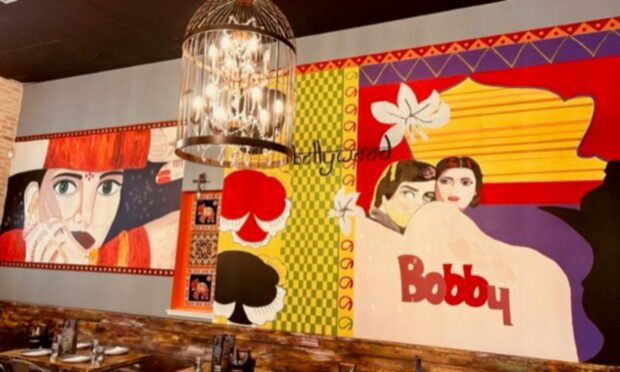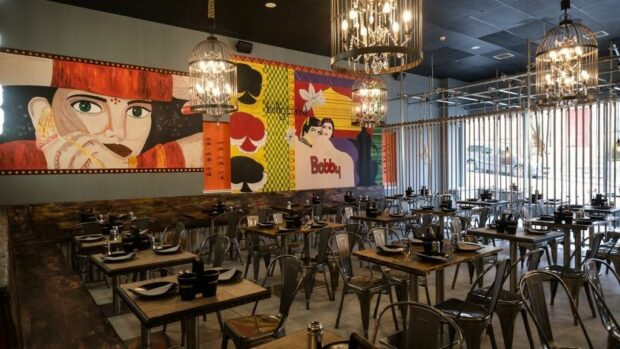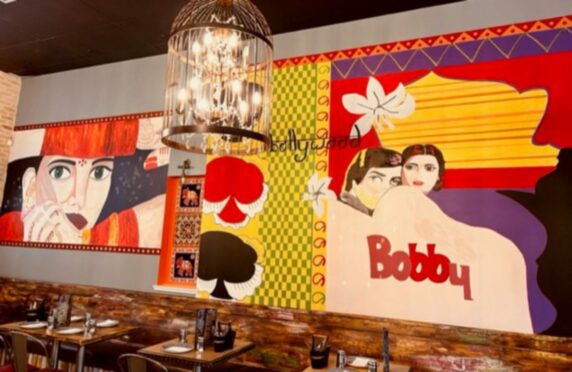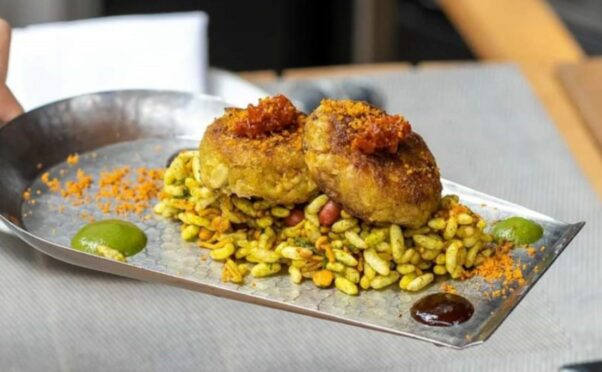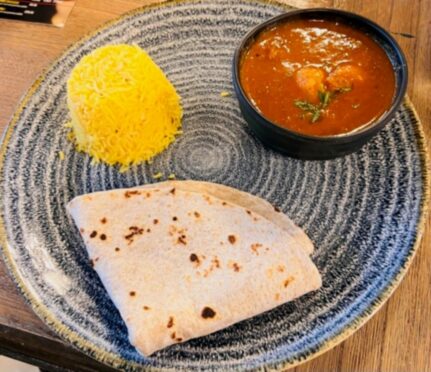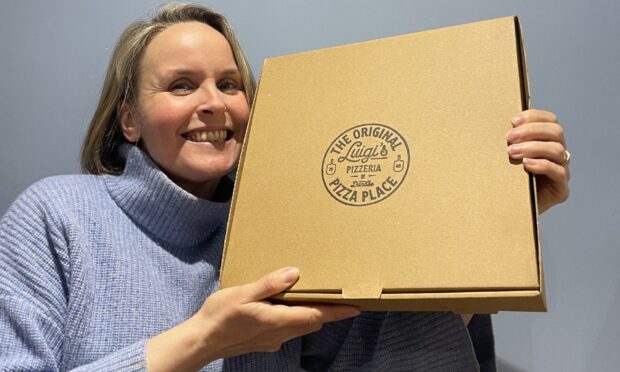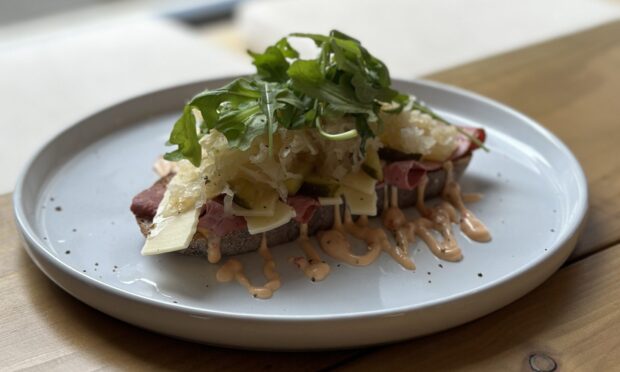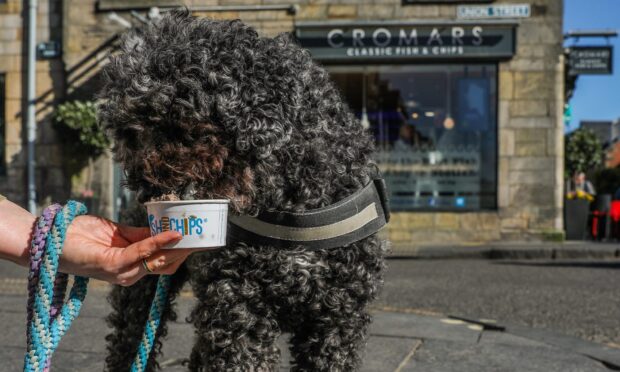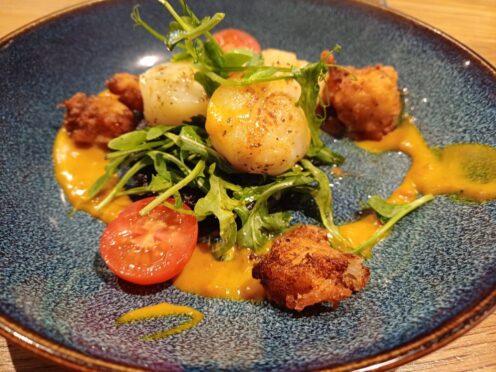This was my first visit to Dunfermline, although anywhere that spawned Andrew Carnegie, Iain Banks and the Skids is always going to be
OK by me.
We visited the town on an antiques hunt although we could easily have spent our time there on an architectural and cultural trail – the ghost of Andrew Carnegie looms large and, less obviously, the old fire station is well worth a visit, should your taste embrace classic modernism.
Instead, we had lunch and left more intellectual pursuits for next time.
Surroundings of Dhoom
This isn’t to say there’s nothing cerebral or life-affirming about great food served in a transformative environment – because this is exactly what you get here at Dhoom, which claims to be the only restaurant of its type in Scotland.
Dhoom means “celebration” and the restaurant celebrates “authentic” Indian street food.
Now, without wishing in any way to denigrate the Dhoom experience (we loved it and can’t wait to go back), I have to say there are quite a few other places claiming to serve Indian street food in this country, albeit not so much outside Edinburgh and Glasgow.
Meantime small chains like Dishoom (with a branch in Edinburgh) have attempted to urbanise Indian food and, like many other Indian restaurants, have small plate-street food sections on their menus, alongside the more traditional offerings.
The idea of serving Indian food “tapas style” (apologies for the cross-cultural referencing but I’m merely echoing the descriptions on some menus I’ve seen) is not a new one but it is welcome.
It’s not always that you want a huge curry and, for many, the whole notion of a “classic” Indian meal experience, from the hot towels to the lie down afterwards, needed a rethink.
When it comes down to the authenticity of this food, however, where do we begin? And does it really matter?
As with other major cuisines, what we define as authentic Indian food was originally a product of many other influences, especially given the size and diversity of the subcontinent.
Subsequently, Anglo-Indian food itself grew during colonialism, when dishes like kedgeree and mulligatawny soup became examples of what we might now fancifully call fusion food.
A fascinating history of Anglo-Indian food by Debabrata Mukherjee can be found at www.historicuk.com – here the writer states that seamen returning to the UK from the Second World War “bought bombed-out chippies and cafes selling curry and rice alongside fish, chips and pies. T
hey stayed open after 11pm to catch the after-pub trade. Eating hot curry after a night out in the pub became a tradition. As customers became increasingly fond of curry, these restaurants discarded British dishes and turned into inexpensive Indian takeaways and eateries”.
As ever in modern life, we have to wonder how we define authenticity when we can still order curry sauce with our chips and think of that after-pub liaison as a British meal, along with chicken tikka masala.
Dhoom serve a mac and cheese pakora (£5.95) and an Indo-Scott (sic) haggis pakora (also £6.50) and that feels less about authenticity and more a gimmick, unless it’s a comment on the great melting pot of food and culture itself.
Whatever you think about such culinary explorations, the menu at Dhoom is based on the knowledge and skills of a chef who has opened 52 restaurants worldwide and still travels extensively throughout his native country researching ideas to bring back to Scotland.
As such you’re in very good hands here.
In 2001 I bought a book called The New Tastes of India by Das Sreedharan (out of print but used copies widely available online). This book was a revelation because it brought the cooking of Rasa in London into the domain of the domestic kitchen.
Some 21 years ago, Rasa was one of my favourite Indian restaurants because it championed the lightness of Keralan cooking in the capital, most markedly in a restaurant close to my house in Marylebone.
It was here that I really learned about the subtlety of Indian food, a statement that now seems idiotic and patronising but it’s true to say that, until then, the Indian food many of us had known was confined to the bombast of the Friday night curry.
Rasa helped unlock my palate to the wonders of tomato rasam and bhindi thoran and avial, that most delicious mixture of vegetables, light spicing and coconut.
Together with a lifelong interest in Ayurvedic medicine and cookery, I’m always drawn to a style of Indian cooking which emphasises lightness and freshness, most notably when cooking without meat.
There is nothing more restorative to me than a dal and it is largely to Indian vegetarian food that I gravitate for culinary comfort and joy, especially in the dreich depths of winter.
Dhoom seemed to offer the flavour explosions needed to offset the cold outside.
It was while chatting to the restaurant’s highly-affable chef-director Dhaneshwar Prasad that he said that he would soon go back to his home city of Delhi on a five-week trip to research and formulate new ideas for the restaurant.
From Dunfermline to Delhi is a long way to go to discover new recipes, but it’s a mark of this chef’s dedication that when I emailed him a few days later to check some facts for this review he was already at work in India. No doubt he will return bursting with new ideas.
Dhoom opened in November 2018 and I imagine it shook up the dining scene in Dunfermline.
Firstly, it looks great.
Set in a row of nondescript shops, Dhoom’s charms creep up on you the closer you get.
Is that rope swings hanging in the window and a couple of Tuk Tuks just visible inside?
Instantly you feel transported, even if the vehicles themselves are static and conceal
dining tables.
This is a simple yet glorious space which tries to replicate the idea of an Indian street market. It’s vibrant, playful and colourful, the whole of one wall is covered by two murals – one of which looked like Trojan, the legendary London artist and collaborator of Leigh Bowery, who died at the age of 20.
The verve of this interior is matched by the service, which was exemplary. From the chef himself, who somehow managed to be in the kitchen and also front-of-house to greet new customers, to our charming waiter and the rest of the staff, this was a place to feel cosseted and happy.
The food
There’s a set lunch for £12.95 which the waiter recommended we both have. To his credit, when I suggested we order a few extra dishes from the a la carte menu he said there was plenty of food in the set menu and that we wouldn’t go hungry. He was right.
The menu we tried (one with meat, one without) is called Namaste India and the aim is to give diners a carefully-balanced selection of dishes from the north, south, east and west of India.
A pre-starter of tomato shorba was an intense, thick broth which is made using 25 spices. It was so rich and deeply aromatic that I felt its warmth slip all the way down my throat and the residual effect was so powerful I felt warmed and nourished from within. A bit like a good malt really – but better for you.
The set lunch includes four starters and all were wonderful – crisp Southern tapioca tikki, bhojpuri dal chawal, chicken 65 and crispy conzy mince. The presentation of each was excellent and the tastes assertive and yet harmonious .
Of the four, the chicken 65 was probably my favourite, the boneless chicken marinated in a ginger and garlic paste, fried and then coated in a pungent hot chilli garlic sauce.
The bhojpuri dal chawal was a close runner up though – a delicious lentil and rice dumpling, mixed with grated coconut.
As you might expect here, the vegetarian food is easily as interesting as the meat equivalents and David was very happy with each of his starters although we both felt that the mac and cheese pakora was a cultural exchange too far.
The texture of the mac and cheese seemed quite alien to the pakora, and that’s before you even get to the wisdom of putting coriander with cheddar cheese. A novelty but, for us, not a keeper.
My main course railway canteen lamb was the star of the show, a rich, earthy, unctuous stew of tender lamb, potatoes and punchy sauce. Served with perfectly cooked rice and chapati, it was absolutely great and I could have eaten double
the portion.
David’s chana aloo was also excellent, a fragrant chickpea and potato curry that was perfectly balanced and felt nourishing despite (or perhaps because of) the carb overload.
We splashed out on dessert and ordered three, mainly because we both love kulfi and decided to share a pistachio version (£3.95). With it we had a gajar halwa wrap (£3.95) and a classic gulab jamun (also £3.95). I preferred the wrap because I loved the combination of carrot, milk and sugar.
The aromatic fug of Indian tea (£1.95) closed a lovely lunch.
The verdict
When we’d entered the place there had only been one table occupied. When we left it was nearly full. The space felt alive.
But that’s not all.
When we arrived, we were slightly down in the dumps, our bones shivering from the cold.
Ninety minutes later we left feeling nourished, happy and looking forward
to spring – and that was without the benefit of Dhoom’s Indian cocktails (£7.95).
If that isn’t something to celebrate and inspire a return visit then I don’t know what is.
Information
Address: Dhoom, 19-21 New Row, Dunfermline, KY12 7EA
Price: Set lunch £12.95, starters from £5.95, mains from £7.50, desserts from £3.95
T: 01383 223340
W: www.dhoomuk.co.uk
Scores:
- Food: 5/5
- Service: 5/5
- Surroundings: 5/5
